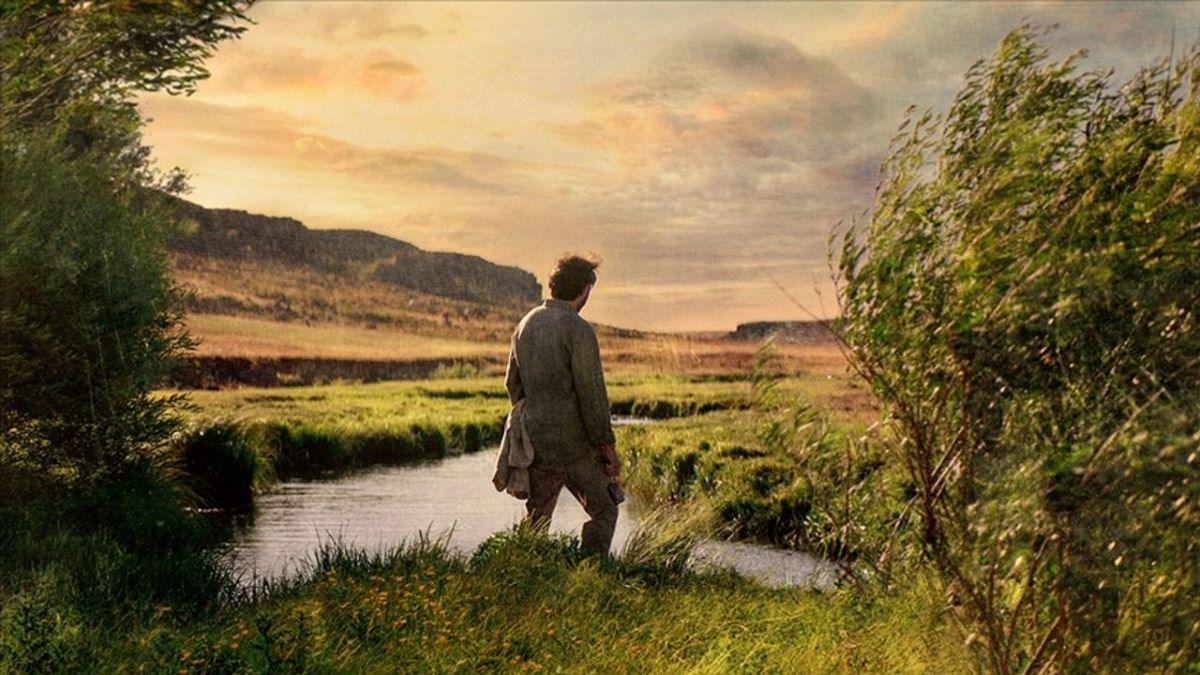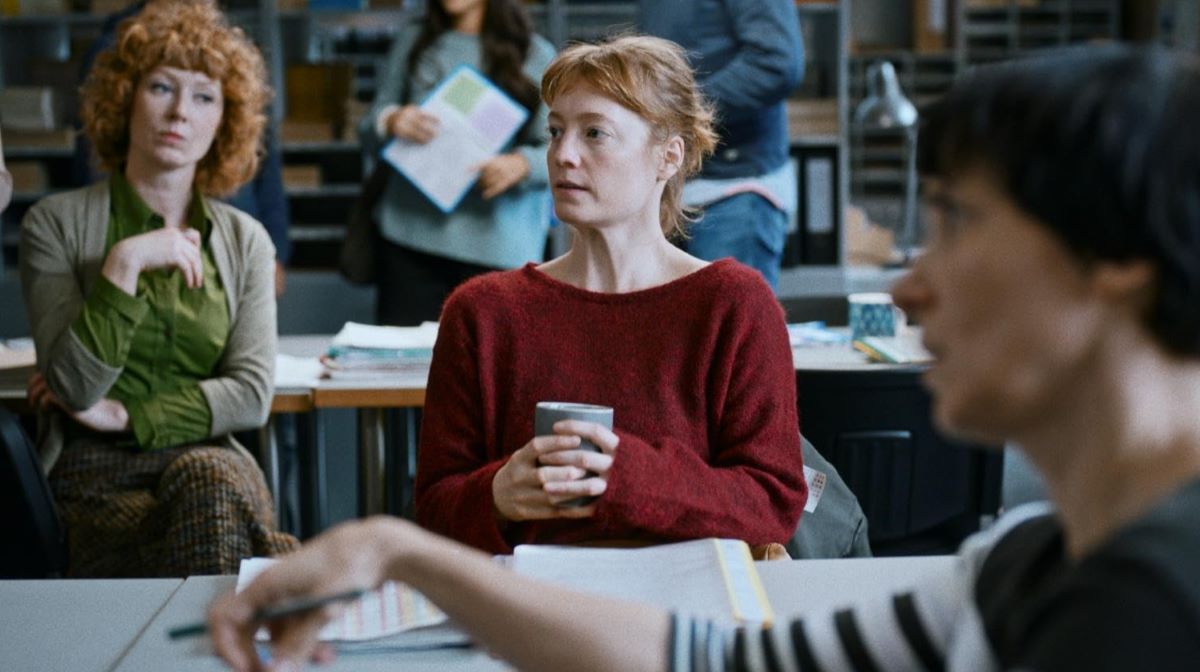About Dry Grasses (2023)
(Turkish: Kuru Otlar Üstüne)
Directed by Nuri Bilge Ceylan
Nuri Bilge Ceylan returns to the Cannes Film Festival with About Dry Grasses, a film that revisits many of the most powerful themes of the Turkish director’s cinema, from the intellectual’s crisis to the necessity of utopia. It is a powerful film, rich in philosophical and human depth.
A Talkative Film
Samet has been teaching art for seven years at a school in a small, isolated village in central Anatolia, sharing a house with a young professor like him, Kenan. Disenchanted and dissatisfied, Samet feels he has a strong bond with one of his pre-adolescent students, Sevim, but this very bond leads to a summons to the local education office, along with his roommate.
At the end of the 197 minutes of About Dry Grasses, one has the distinct impression of having witnessed a perfectly crafted drama and something rare and precious: a sweeping novel, a deeply layered text written by Nuri Bilge Ceylan along with his wife (and usual collaborator) Ebru Ceylan, and screenwriter Akin Aksu – the same “trio” that signed the previous magnificent work of the Turkish director, The Wild Pear Tree (2018). This impression is confirmed when reflecting on the film’s narrative structure, which is organic and sophisticated, the precision of the dialogues – all punctual, incisive, essential, and realistic – and the psychological depth of the protagonists, as well as the ability to meticulously portray any character appearing on the scene, even for just two minutes, through a gesture, a line, a reaction. About Dry Grasses is a dramaturgically imposing work, comparable to or even surpassing Ceylan’s other works.
Moreover, after the intense and engaging three hours, the high quality of the direction of About Dry Grasses also comes to mind. The film opens with a long shot where the sky and the earth are both white due to a snowstorm, making their boundaries indistinguishable, and continues by often keeping a distance from the characters, frequently with static shots, and then gradually becoming a palpable, increasingly mobile, and dialectical gaze, eventually breaking the fourth wall and ending symbolically on details of wild grasses in the ground during the summer, a hot but brief season in the central/eastern Anatolian village where this great film is set.
About Dry Grasses tells the story of Samet (Deniz Celiloglu), a forty-year-old professor who has been living and teaching art in a comprehensive school in a truly remote village in a province with a strong Kurdish presence for seven years. The man, who is not married and has no desire to “settle down,” lives with his peer Kenan (Musab Ekici), also a professor at the same school. There are two main events: the first builds around the close relationship between Samet and his pre-adolescent student Sevim (Ece Bagci), which becomes the film’s central conflict when the girl and a friend “report” the teacher, and also his roommate Kenan, to the principal, claiming that the two had inappropriate and ambiguous behavior towards them. The matter, in itself, leads to nothing, as it is refuted by other students, but the initially exclusive and special relationship between Samet and Sevim changes drastically, creating a void in the protagonist.
The second main event, reflecting the first, is the arrival in the lives of the two men of an emancipated and militant English teacher, Nuray (Merve Dizdar), who lived in Istanbul and Ankara and now, after losing a leg in an attack in the Turkish capital, has returned to this deprived place to live with her family. It is Samet who seeks out and meets the beautiful Nuray, ostensibly to introduce her to Kenan, who is looking for a wife, but in the end, things are far from straightforward. Alongside these two main plots are side stories, none of which are irrelevant or idle, but the protagonists are certainly Samet, who is the film’s point of view from the beginning, and Nuray, with Kenan as a “supporting character” and Sevim as a subject/object of hope, utopia, dream, and seduction.
As in Ceylan’s recent works, the focus is on the Turkish leftist intellectual class (both in the aforementioned The Wild Pear Tree and in the 2014 Palme d’Or winner Winter Sleep) embodied by a secular woman who has been politically active (but is now mutilated), namely Nuray, but more so by the individualistic, disenchanted Samet. Like the protagonists of the director’s previous films, Samet is often insufferable: arrogant, manipulative, deceitful with others, and always self-aware. Samet epitomizes distrust and the inability to identify with the collective, not only in relation to the country’s religious or cultural traditions, which are largely behind most characters, but also in relation to ideologies and the “struggles” of the contemporary world.
In this sense, the ambiguous relationship with Sevim is excellently handled by Ceylan: About Dry Grasses confronts both modern philosophical issues in a quasi-Dostoevskian manner (the conflict between an individual who cannot truly believe in anything and the ethical-political realm) and some purely contemporary themes, such as harassment and the role of women, indicating that changes in sensibilities are also present in an isolated part of Turkey. The appropriateness of the relationship with a student, which Ceylan imbues with sublime ambiguity, becomes an opportunity for debate in a series of scenes that constitute a reflection on participation, speaking and engaging or dividing the world into black and white, embracing an idea or analyzing it. Being deeply reflective and taking a stance is, for Ceylan, a paradox, an inescapable lie.
Around the relationships between the three main characters, further disillusionment about the possibility of political action and the many personal contradictions that can only grow in a society increasingly demanding clear positions develop. The magnificent sequence at Nuray’s house is the most evident expression of Ceylan’s operation throughout the film: the woman and Samet candidly confront their vastly different perspectives on the meaning of acting in society, and it is in this sequence that Ceylan brings his character out of the scene. At one point, Samet opens a door that leads him out of the film itself, behind the scenes, and after reflecting in a mirror, returns to Nuray’s living room.
The director externally shows what the character – who in one scene gives his students an assignment on perspective – constantly does: by revealing, in a game between reality and cinematic fiction, the protagonist’s psychological movement, Ceylan shows us the continuous work of self-representation that remains the only field of action for this fierce but impotent intellectual, who is sadly truthful but unable to find in collective action an authentic form for his brutal but rich intimacy. The inability to be part of anything is the movement that always shifts the positive outcome even of one’s own existence elsewhere, and on this, Nuray proves decisive for Samet, a man who graduated in art history but stopped drawing (unable to consider even that act complete), but instead takes photographs, perhaps closer to reality for him and perhaps requiring fewer choices on his part.
Nuray, on the other hand, draws, talks, pins him down, and exposes him: the protagonist, in his consciously adopted disguises, lies even to himself, and the two women reflect, in different ways, Samet’s self-indulgence. The two roommates, on the other hand, do not talk. The two men simply would not be able to elaborate on themselves. The woman is the only vehicle, if not of truth, then of revelation and search. While Nuray, adult and extremely intelligent, understands everything and cannot be “fooled,” Sevim’s role is perhaps the most important of all, certainly the most poetic and tragic.
The matter between her and her teacher has little to do with Humbert Humbert and Lolita (or perhaps it does, at least according to a non-superficial reading of Lolita) but rather with Samet’s inability even to not cultivate a form of utopia. Trapped in his individualism, which prevents him from taking decipherable action in the social body, Samet has found his escape route, his hope for the future. But Sevim’s youth is merely a desire for the future, a utopian change projected onto a girl who does not know and cannot understand.
The ending focusing on her, an elegy of images imagined with Samet’s voiceover in a poignant confession, is magnificent. Equally crucial is the “closure” of the narrative arc involving the three main characters, who finally become true friends and visit one of Turkey’s oldest archaeological sites, Nemrut Dağı: in the monumental persistence of time, the ground leading to the hilltop is covered with dry grass that the brief and intense summer burns before the winter months. There is little left for this singular human being in a present that cannot allow for a choice but where every action is a decision: the awareness of this aporetic position makes Samet more empathetic, finally able to take a step forward.
Snow covers the landscape for almost the entire film, a dialogue-driven narrative where the direction is as detailed and vibrant as the conversations. Persistent images of the father of the nation, Atatürk, on numerous walls in one scene become a close-up that engulfs Samet’s gaze. The distances between characters always reflect the level of truth they share with each other. The lyrical conclusion of the reflections on the young student is a poem about the flow of life and the dream of grasping it. The dissolves from winter to summer signal a renewed self-awareness after a dense journey filled with meaningful words. The allusive faces and gestures, the visual omissions and details in the environments, the lighting of the scenes (starting from the first interior shot at Samet and Kenan’s home), and the photographs taken by the protagonist in his quest to capture a form of truth—all these details contribute to making About Dry Grasses a significant existential and political film about our present and the transience of forms, called to be something in a world where the value of collective action continually eludes us.
Elisa Battistini
Quinlan, May 20, 2023





